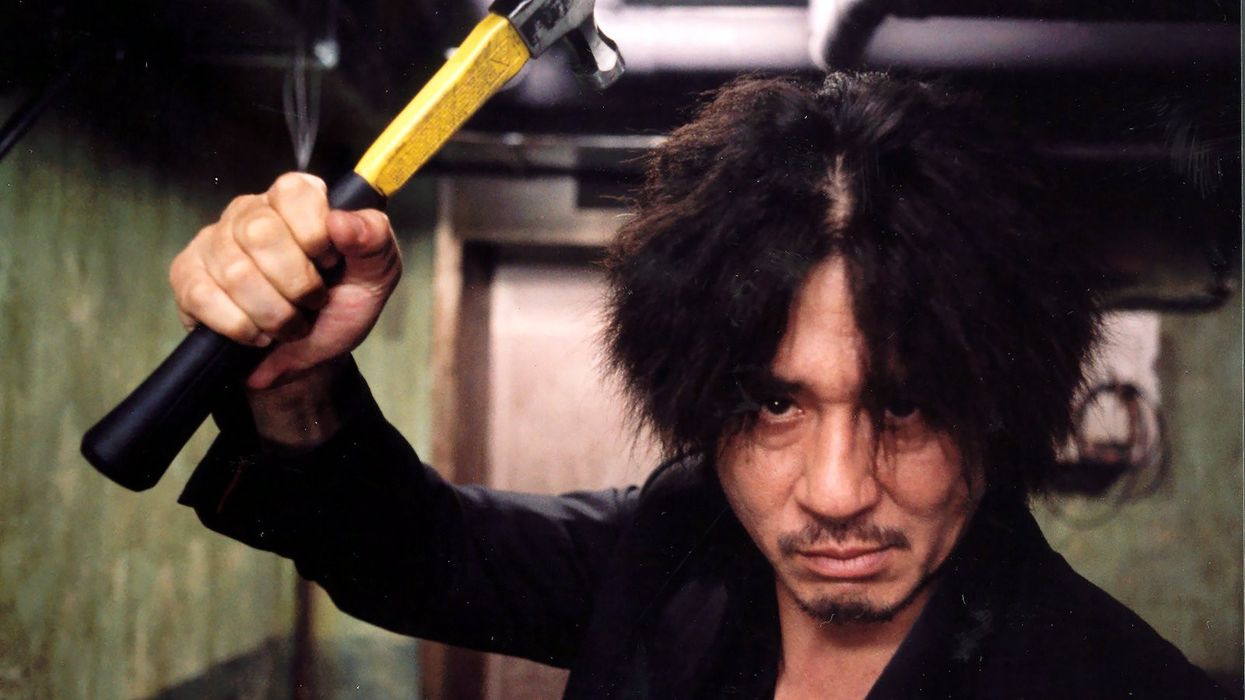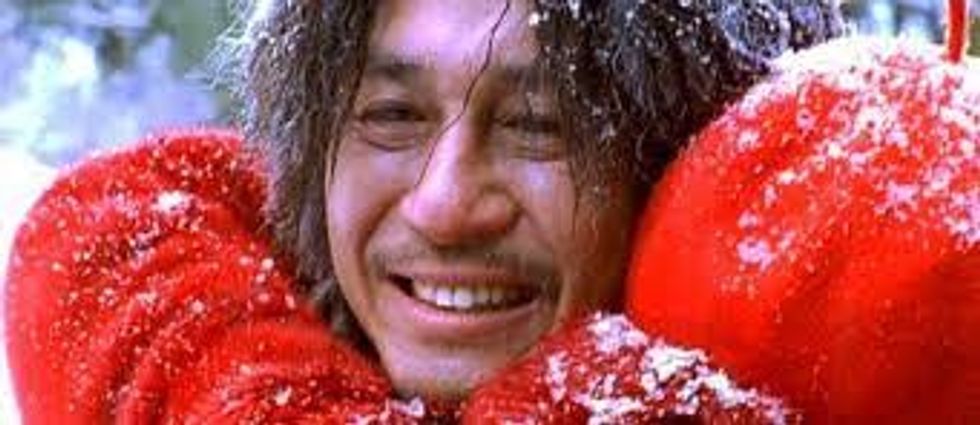What Are the Most Violent Movie Scenes of All Time?
Filmmakers continue to push the limits with these violent movie scenes.

Director Park Chan-wook Discusses the Legacy of Oldboy
Film is the most powerful visual medium we have on this planet. Roger Ebert called it an empathy machine. And filmmakers have used it to convey intense emotions, highlight certain realities, or simply push the boundaries of storytelling.
One of the ways they do that is to incorporate violence.
While the debate around the depiction of violence in movies continues, it's undeniable that some scenes have left an indelible mark on film history for their raw, unflinching portrayal of brutality.
Today, we delve into what are considered some of the most violent movie scenes of all time. These scenes, selected for their impact, creativity, and how they've shaped the cinematic landscape, are not for the faint of heart.
Let's dive in.
A History of Violence in Film
Violence has always been a part of movies, but it has evolved significantly over the course of history, reflecting broader social, cultural, and technological changes.
From the early days of silent film to the contemporary era of digital effects, filmmakers have grappled with the depiction of violence, balancing artistic expression, ethical considerations, and audience sensibilities.
It feels like every generation has a movie that "goes too far" and resets the bar.
Let's look at how violence in the cinema has changed over the years.
The Silent Film Era

Psycho
Universal Studios
In the silent film era and early sound films, violence was present but largely implied or shown in a sanitized manner due to technological limitations and strict moral standards.
The Hays Code, implemented between 1934 and 1968, enforced these standards in Hollywood, dictating what could be shown on screen.
Violence had to be essential to the plot and not overly detailed or glorified.
Despite these restrictions, filmmakers like Alfred Hitchcock in Psycho (1960) found creative ways to suggest violence, using editing, sound, and camera angles to evoke a visceral response without explicit depiction.
The 1960s and 1970s

Bonnie and Clyde
Warner Bros.
The late 1960s and 1970s marked a significant shift, as cultural and social upheavals led to a questioning of previous norms and taboos, including those around the depiction of violence.
Films like Arthur Penn's Bonnie and Clyde (1967) and Sam Peckinpah's The Wild Bunch (1969) featured graphic violence that shocked audiences and critics alike, challenging the Hays Code and paving the way for the more permissive MPAA rating system.
This era also saw the rise of the New Hollywood movement, with directors like Francis Ford Coppola and Martin Scorsese exploring violence not just as action but as a complex social and psychological phenomenon.
A Clockwork Orange (1971), directed by Stanley Kubrick, pushed boundaries further with its stylized yet disturbing portrayal of violence, questioning the nature of free will and the ethics of psychological conditioning.
The 1980s and 1990s

Robocop
MGMThe advent of blockbuster cinema in the 1980s, along with advances in special effects technology, saw violence becoming more spectacular and visceral.
Films like RoboCop (1987) and Die Hard (1988) showcased elaborate action sequences and set pieces, with violence serving as both spectacle and a means of thrilling the audience.
This period also saw filmmakers using violence as a form of social commentary or satire. Paul Verhoeven's RoboCop, for instance, critiqued corporate greed and dehumanization in a dystopian Detroit, using exaggerated violence to underscore its themes.
The 21st Century

City of God
Criterion
The turn of the millennium brought a new era of realism and reflection in the portrayal of violence. Films like Saving Private Ryan (1998) and City of God (2002) aimed for a more authentic depiction of violence, focusing on its impact on individuals and communities.
The use of digital effects allowed for more graphic and realistic portrayals, challenging audiences to confront the consequences of violence.
Simultaneously, the genre of psychological thrillers and horror films, such as Saw (2004) and The Dark Knight (2008), explored the psychological dimensions of violence, examining its roots in human nature and society.
The Role of Global Cinema

Oldboy
Neon
It's also important to acknowledge the contribution of global cinema to the discourse on film violence.
Asian cinema, for instance, has offered unique perspectives, from the stylized violence of Akira Kurosawa's samurai films to the brutal realism of South Korean thrillers like Oldboy (2003).
European cinema, too, has tackled the theme of violence in varied and innovative ways, from the existential brutality of Ingmar Bergman's The Virgin Spring (1960) to the visceral intensity of Gaspar Noé's Irreversible (2002).
Every culture deals with violence in a different way, and watching their most violent movies can be a window into social morays and ideas.
What Are the Most Violent Movie Scenes of All Time?

A Clockwork Orange
Warner Bros.
There's always going to be a debate on how violent a movie is and whether or not it matters. Violence can be used for scares, for humor, or just to be thrilling.
But it's an effective tool that each film on this lists to make a point.
- Saving Private Ryan (1998) - The Omaha Beach Landing: Directed by Steven Spielberg, this World War II epic opens with one of the most harrowing depictions of combat ever put on screen. The Omaha Beach assault on D-Day is a masterclass in sound design, cinematography, and practical effects, immersing the audience in the chaos and carnage of war. The visceral realism and relentless violence of this scene set a new standard for war movies.
- Psycho (1960) - The Shower Scene: Alfred Hitchcock's Psycho revolutionized the horror genre with its shower scene, where the character Marion Crane is brutally murdered. This scene is a masterpiece of suspense and terror, utilizing quick cuts, shadow play, and the chilling strings of Bernard Herrmann's score to create an atmosphere of intense fear without showing explicit violence. Hitchcock's ingenious use of suggestion rather than graphic depiction made the violence feel more real and terrifying, forever changing the way filmmakers approached horror.
- Irreversible (2002) - The Tunnel Scene: Gaspar Noé's controversial film is structured in reverse chronological order and contains one of the most brutal and prolonged scenes of violence and sexual assault in cinema history. Taking place in a grimy underpass, the scene's graphic nature and the unyielding manner in which it's presented make it incredibly difficult to watch, sparking debates on the portrayal of violence in film.
- Oldboy (2003) - The Hallway Hammer Fight: Park Chan-wook's masterpiece of revenge cinema features a single-take scene where the protagonist, Oh Dae-su, battles his way through a corridor of adversaries with nothing but a hammer. The choreography and sheer physicality of the scene, combined with its raw brutality, make it a standout moment in action cinema.
- The Texas Chainsaw Massacre (1974) - The Hook Scene: Tobe Hooper's The Texas Chainsaw Massacre terrified audiences with its depiction of raw, unadulterated horror. The hook scene, where a victim is impaled alive, is particularly gruesome. Despite showing less on-screen gore than modern horror films, the scene's power lies in its ability to suggest horror through sound and the victim's reactions, leaving the rest to the audience's imagination. This technique proved profoundly disturbing, making the film a landmark in the horror genre.
- Battle Royale (2000) - The Lighthouse Scene: Kinji Fukasaku's cult classic about high school students forced to fight to the death is filled with violent moments, but the lighthouse scene stands out. It's a shocking sequence of paranoia-fueled violence among friends, showcasing the tragic and senseless nature of the film's premise.
- A Clockwork Orange (1971) - The Home Invasion Scene: Stanley Kubrick's dystopian crime film features several disturbing scenes, but the home invasion by Alex and his droogs, set to "Singin' in the Rain," is particularly unsettling. The juxtaposition of violence with a cheerful tune creates a deeply disconcerting effect.
- The Passion of the Christ (2004) - The Scourging Scene: Mel Gibson's depiction of the last 12 hours of Jesus Christ's life includes a graphic and prolonged scourging that is intensely brutal. The scene's explicit portrayal of physical suffering is both controversial and unforgettable.
- Reservoir Dogs (1992) - The Ear Scene: Quentin Tarantino's debut film features a scene where Mr. Blonde tortures a police officer while dancing to "Stuck in the Middle with You." The casual cruelty and the way the violence is partly left to the audience's imagination make it a landmark moment in film.
- The Godfather (1972) - The Toll Booth Scene: In The Godfather, Sonny Corleone's assassination at a toll booth is one of the film's most brutal moments. Directed by Francis Ford Coppola, this scene is a masterclass in building tension, culminating in a shocking burst of violence as Sonny is trapped and mercilessly gunned down. The scene's impact is heightened by its contrast with the film's otherwise measured pacing and its significance in the narrative, marking a pivotal moment in the Corleone family saga.
- 12 Years a Slave (2013) - The Whipping Scene: Steve McQueen portrays the brutality of American slavery, particularly in a scene where the protagonist, Solomon Northup, is forced to whip his fellow slave, Patsey. The scene's unflinching depiction of violence and the emotional turmoil experienced by the characters make it a powerful testament to the inhumanity of slavery. McQueen's refusal to shy away from the harsh realities of America's past makes this moment one of the most impactful in the film.
- Pan's Labyrinth (2006) - The Bottle Scene: Guillermo del Toro's dark fairy tale is not without its moments of brutal violence, none more shocking than the scene where Captain Vidal beats a man's face in with a wine bottle. The brutality serves to underline the real monsters of the story: the fascists.
- American History X (1998) - The Curb Stomp Scene: Tony Kaye's film about neo-Nazis in America features a scene of such shocking violence that it's often the only thing some viewers remember. The curb stomp is a horrifying act of racial violence that's both graphic and psychologically disturbing.
- Bonnie and Clyde (1967) - The Ambush Scene: This movie broke new ground with its portrayal of violence, culminating in the ambush that kills the titular characters. Directed by Arthur Penn, the scene's use of slow-motion and close-ups to capture the balletic fall of bodies riddled with bullets was both shocking and visually stunning. This graphic finale challenged Hollywood's previous limitations on violence, marking a significant moment in the evolution of American cinema and its capacity for on-screen realism.
- Scarface (1983) - The Chainsaw Scene: Brian De Palma's Scarface features one of cinema's most gruesome scenes, where Tony Montana witnesses a man being dismembered with a chainsaw. The scene's explicit violence was shocking for its time, pushing the boundaries of what was acceptable in mainstream cinema. Its raw intensity serves not only to shock but to underline the film's exploration of the brutal realities of the drug trade and the corrupting power of violence.
These are scenes that stuck out to me, but I bet you have other ones to add to the list. As filmmakers continue to explore and push the boundaries of how violence is depicted, audiences are compelled to confront its implications, both on screen and in the real world.
Whether as a tool for spectacle, a means of psychological exploration, or a commentary on social issues, the portrayal of violence remains a central, though controversial, element of cinematic expression.
Let me know what you think in the comments.
- The 11 Greatest Fist Fights In Action Movies, Ranked ›
- Watch the Best and Goriest Scenes in Cinema ›
- Watch: The Most Disturbing PG Moments in Movie History ›











